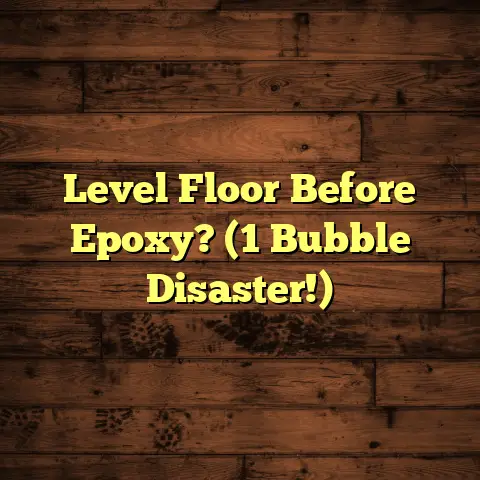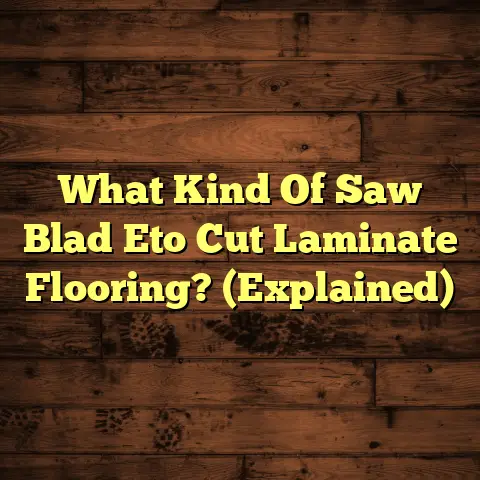Pine Sol On Vinyl: Good Choice? (1 Pro, 1 Con)
Trust me, I’ve seen it all – from epic juice spills to muddy paw prints that seem to defy gravity.
Recently, I was chatting with a young family, the Millers, who had just installed gorgeous new vinyl plank flooring in their kitchen. They were so proud!
But a few weeks later, the initial excitement faded.
Spaghetti sauce splatters, coffee drips, and the general wear-and-tear of daily life had taken their toll.
They were overwhelmed by the sheer number of cleaning products promising to restore their floors to their former glory.
“Mike,” Mrs. Miller asked, “What about Pine Sol? I’ve heard it’s a powerhouse.”
That’s a question I get a lot.
Pine Sol is a classic, and it’s known for its cleaning punch.
But is it the right choice for vinyl? That’s what we’re going to unpack today.
I’m going to give you the straight goods, based on my years of experience.
Section 1: Understanding Vinyl Flooring
Okay, let’s start with the basics.
What exactly is vinyl flooring?
Well, it’s a synthetic flooring made from polyvinyl chloride (PVC) and other compounds.
Think of it as a multi-layered sandwich, designed for durability and water resistance.
You’ve got your backing layer, a core layer for stability, a printed design layer (that’s the pretty part!), and a top wear layer for protection.
Types of Vinyl Flooring:
-
Sheet Vinyl: This comes in large rolls, minimizing seams and offering excellent water resistance. It’s like a giant, continuous vinyl blanket for your floor.
-
Vinyl Tile (LVT/LVP): Luxury Vinyl Tile (LVT) and Luxury Vinyl Plank (LVP) are individual pieces that mimic the look of stone, ceramic tile, or hardwood.
They offer more design flexibility and can be easier to repair than sheet vinyl.
Vinyl has become a super popular choice, and it’s easy to see why.
Here’s a quick rundown of the perks:
-
Durability: Vinyl can withstand a lot of foot traffic, making it great for busy households.
-
Water Resistance: Spills? No problem (usually!). Vinyl is inherently water-resistant, making it ideal for kitchens and bathrooms.
-
Ease of Installation: Many vinyl products are designed for DIY installation, saving you money on labor costs.
-
Affordability: Compared to hardwood or tile, vinyl is often a more budget-friendly option.
But here’s the thing: even though vinyl is tough, it’s not invincible.
Common Vinyl Flooring Challenges:
-
Scratching: While the wear layer offers protection, sharp objects can still scratch the surface.
-
Discoloration: Prolonged exposure to sunlight or certain chemicals can cause fading or discoloration.
-
Denting: Heavy furniture or appliances can leave dents, especially on softer vinyl types.
-
The Wrong Cleaners: Using harsh or abrasive cleaners can damage the wear layer, dull the finish, or even cause discoloration.
That last point is crucial, and it brings us back to our original question:
What’s the right way to clean vinyl?
And specifically, what about Pine Sol?
Section 2: The Appeal of Pine Sol
Pine Sol. The name conjures up images of sparkling clean surfaces and a fresh, piney scent.
It’s been a household staple for generations.
But where did it come from?
Pine Sol was first introduced in 1929 as a cleaner and disinfectant.
The original formula was derived from pine oil, giving it that distinctive fragrance.
Over time, the formulation has evolved, but the core concept remains the same: a powerful cleaner designed to tackle tough messes.
Key Ingredients (Generally):
- Pine Oil: Historically, the primary active ingredient.
- Surfactants: These help to loosen dirt and grime.
- Solvents: These help to dissolve grease and oil.
- Chelating Agents: These help to remove mineral deposits and hard water stains.
- Fragrance: To leave a pleasant scent.
Pine Sol is marketed as a multi-surface cleaner, suitable for everything from floors and countertops to bathrooms and kitchens.
The marketing emphasizes its ability to cut through grease, remove stains, and kill germs.
Now, let’s talk about reputation.
Pine Sol has a strong following.
Many people swear by it, citing its effectiveness against tough stains, its ability to eliminate odors, and its long-lasting fresh scent.
You’ll find countless testimonials online praising its cleaning power.
For example, a quick search reveals comments like:
“Pine Sol is the only thing that gets my kitchen floor truly clean!”
“I use Pine Sol for everything! It’s the best disinfectant.”
“The smell of Pine Sol just makes my house feel clean.”
It’s easy to see why families like the Millers are drawn to Pine Sol.
It promises a quick and easy solution to their cleaning woes.
But before you reach for that bottle, let’s dig a little deeper.
Is the reputation justified when it comes to vinyl flooring?
Section 3: The Pros of Using Pine Sol on Vinyl
Okay, let’s be fair.
Pine Sol does have one major advantage when it comes to vinyl:
Its powerful cleaning properties.
Pine Sol is formulated to cut through grease, dissolve dirt, and remove stains.
This can be a real asset when dealing with stubborn messes on your vinyl floor.
Think about those sticky spills, greasy footprints, or ground-in dirt.
Pine Sol can often make quick work of these challenges, leaving your floor looking cleaner and brighter.
I’ve seen it firsthand.
I once worked on a house where the tenants had let the kitchen floor go for months.
It was a disaster zone of dried food, grime, and who-knows-what-else.
We tried a few milder cleaners, but nothing seemed to make a dent.
Finally, we cautiously tested a diluted Pine Sol solution on a small, inconspicuous area.
To our surprise, it worked!
The Pine Sol cut through the grime, lifted the stains, and restored the floor to a presentable condition.
Of course, we followed up with a thorough rinse to remove any residue.
But that experience showed me that Pine Sol can be a valuable tool in certain situations.
There are also testimonials from satisfied users.
For example, I found this online:
“I spilled motor oil on my vinyl floor in the garage. I thought it was ruined. But I diluted some Pine Sol in water and scrubbed it with a brush, and the stain came right up!”
However, it’s important to remember that this is just one side of the story.
While Pine Sol can be effective, it also comes with risks.
Section 4: The Cons of Using Pine Sol on Vinyl
Now for the not-so-good news.
While Pine Sol’s cleaning power is undeniable, there’s a significant con to consider:
The risk of leaving a residue and potentially damaging the vinyl over time.
Pine Sol contains surfactants and solvents that, if not properly rinsed, can leave a sticky or dulling residue on your vinyl floor.
This residue can attract dirt and grime, making your floor look even worse in the long run.
More concerning, some of the chemicals in Pine Sol can potentially react with the vinyl over time, leading to discoloration, fading, or even damage to the wear layer.
I’ve seen this happen firsthand.
A few years ago, a client called me in to assess damage to their vinyl kitchen floor.
They had been using Pine Sol regularly for years, believing it was the best way to keep their floors clean.
However, over time, they noticed that the floor was becoming dull and discolored, especially in high-traffic areas.
Upon closer inspection, I found that the Pine Sol had gradually worn down the wear layer, exposing the printed design layer underneath.
The damage was irreversible, and the only solution was to replace the entire floor.
This is not an isolated incident.
I’ve heard similar stories from other flooring professionals and homeowners.
For example, I found this cautionary tale online:
“I used Pine Sol on my vinyl floor for years, and it looked great at first. But after a while, I noticed that the floor was starting to look cloudy and dull. I tried everything to restore the shine, but nothing worked. I finally realized that the Pine Sol had damaged the finish.”
The key takeaway here is that Pine Sol, while effective for cleaning, can be a harsh chemical for vinyl flooring.
It needs to be used with extreme caution, if at all.
Proper dilution and thorough rinsing are absolutely crucial to minimize the risk of damage.
But even then, there’s no guarantee that long-term use won’t have negative consequences.
Section 5: Conclusion and Final Thoughts
So, where does this leave us?
Is Pine Sol a good choice for cleaning vinyl flooring?
The answer, as with most things in life, is: it depends.
Pine Sol can be effective for removing stubborn dirt and stains from vinyl.
Its powerful cleaning properties are a definite plus.
However, it also carries the risk of leaving a residue and potentially damaging the vinyl over time.
The key is to weigh the pros and cons carefully.
If you choose to use Pine Sol on your vinyl floor, here are a few crucial guidelines to follow:
-
Dilute, Dilute, Dilute: Always dilute the Pine Sol with plenty of water, following the manufacturer’s instructions carefully. Err on the side of caution and use a weaker solution rather than a stronger one.
-
Test First: Before cleaning your entire floor, test the solution on a small, inconspicuous area to make sure it doesn’t cause any discoloration or damage.
-
Rinse Thoroughly: After cleaning with Pine Sol, rinse the floor thoroughly with clean water to remove any residue. You may need to rinse multiple times to ensure that all traces of the cleaner are gone.
-
Dry Completely: After rinsing, dry the floor completely with a clean cloth or mop. This will help to prevent water spots and further minimize the risk of residue buildup.
-
Consider Alternatives: Explore other cleaning options specifically designed for vinyl flooring. These products are often formulated to be gentler and less likely to cause damage.
I always recommend using cleaning products specifically formulated for vinyl.
They’re designed to clean effectively without damaging the finish or leaving a residue.
Look for pH-neutral cleaners, as these are less likely to cause discoloration or fading.
You can also consider using a simple solution of warm water and mild dish soap.
This is often sufficient for everyday cleaning and is much less likely to cause damage than harsh chemicals.
Ultimately, the best way to maintain your vinyl flooring is to prevent messes in the first place.
Use doormats to trap dirt and debris, clean up spills promptly, and avoid wearing shoes with sharp heels or cleats on the floor.
Regular sweeping or vacuuming can also help to prevent the buildup of dirt and grime.
Maintaining vinyl flooring is an ongoing quest.
It’s about finding the right balance between effective cleaning and long-term preservation.
While Pine Sol may seem like a tempting solution, it’s important to approach it with caution and to be aware of the potential risks.
By understanding the pros and cons, and by following the guidelines outlined above, you can make an informed decision about whether or not to use Pine Sol on your vinyl floor.
And remember, when in doubt, consult with a flooring professional.
We can offer personalized advice based on your specific flooring type and your individual cleaning needs.
Happy cleaning!





